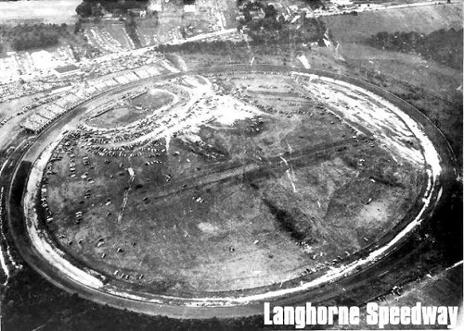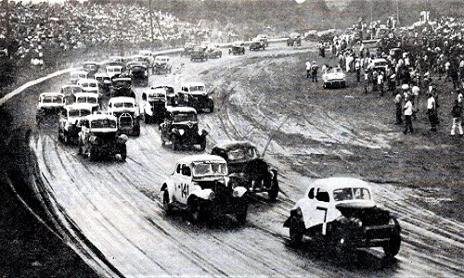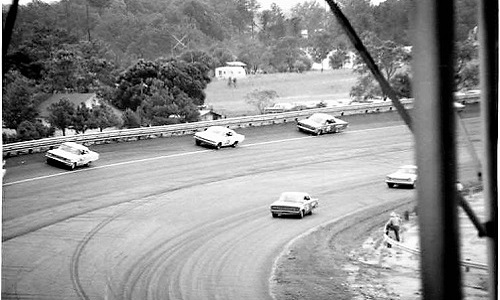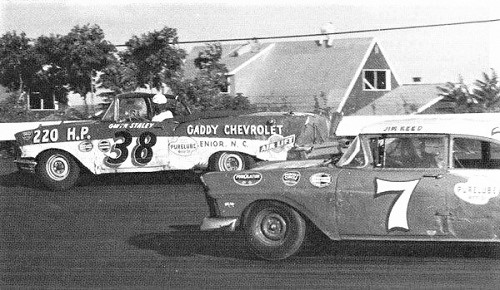LANGHORNE SPEEDWAY - LANGHORNE PA

This one mile dirt circle track was built by members of the National Motor Racing Association and opened on the 12th of June 1926. Over the years, the track acquired nicknames such as "The Horne"; The Big Left Turn", and "The Track That Ate the Heros". The National Motor Racing Association ran mainly 100 lap events at the track, This was a regular Labor Day feature; these events and other shorter races continued through to 1930. The association struggled at managing the venue, as problems such as track preparation, management disputes and poor spectator numbers drove the speedway to near on bankruptcy. Ralph "Pappy" Hankinson: a well known promotor at the time took control of track in 1930, he introduced the AAA Championship Langhorne championship events, as well as shorter sprint racing events. Stock car racing was introduced in 1940 at
Langhorne with "Rapid" Roy Hall from Atlanta Georgia winning the 1st 200 lap event. In 1941 Earl "Lucky" Teter took control of the venue from Hankinson only to be short lived. On July 5th 1942, "Luckies" luck ran out when he died while attempting a rocket car jump at the Indiana State Fairgrounds. Like other tracks, the facility was idle through World War II. Hankinson died only weeks after the US government ban on motorsport was lifted. With the death of Hankinson ownership of the track was passed to John Babcock and his family. The Speedway hosted the nation's most noted race for the Modified division; the first post-war stock car race run at the facility was a National Championship Stock Car Circuit (a forerunner to NASCAR)


race in 1947, with Bob Flock taking home the checkered flag. In September 1949, Langhorne hosted the fourth race of NASCAR's first year of sanctioning unmodified cars, then called Strictly Stock; Curtis Turner won that race beating Bob Flock. 45 drivers started the race including three women. Sara Christian finished sixth. Curtis would return in 1950 to win again. The next five years would see five different winners. They included: Fonty Flock; Herb Thomas; Dick Rathman; Lee Petty and Buck Baker. After that we had a bevy of back-to-back winners. First Rathman won two races in 1953. Then 1954 saw both wins go to Herb Thomas. Tim Flock won both races in 1955. Three more races were held before NASCAR visited for the final time in 1957. It would be a 300 lap
race and Paul Goldsmith (a 1956 winner), would start on the point. He would fall out with a ruptured gas line after 162 laps. Then Jim Reed would fall out with a burned piston after leading up until lap 215. Meanwhile, Gwyn Staley would be working his way forward from his 25th place starting position. When Reed fell out, he found himself in the lead; and would lead the final 85 laps to take his final Cup win. Staley had three career Cup wins; all coming in 1957. Whitey Norman was second, his best career finish but was two laps behind. Johnny Allen finished third as Rex White and Buck Baker made up the top five. NASCAR saw the Convertible series run a couple events here at Langhorne also. In 1956 Danny Letner would get his only


NASCAR win, when he bested Jimmy Massey by over a lap. 1957 would see Curtis Turned lead all 150 laps to beat Joe Weatherly by a scant three seconds. In 1965, one of the most spectacular comebacks in auto racing history began with the serious burns and injuries to Mel Kenyon. Kenyon later returned to racing and placed third at the Indy 500 and won numerous national midget racing championships. By 1965 the round circuit had a back straight added giving the track a D shape. The surface was also sealed with asphalt. By 1967 suburban growth was starting to engulf the track, and the developers were hovering. The site was sold but racing did continue up until 1971 when the track closed. Almost immediately after
Langhorne's closure, the property was razed in order to make way for a new shopping development. The current space features a Sam's Club, a Restaurant Depot warehouse and a CarMax dealership where the pits and grandstand were once located. A heavily overgrown wooded area has completely enveloped the infield and backstretch, while a vacant grocery store and asphalt parking lots around the perimeter of the site cover up the rest. As a result, no physical remnants of the track itself remain.
All Photos copyright and are property of their respective owners
